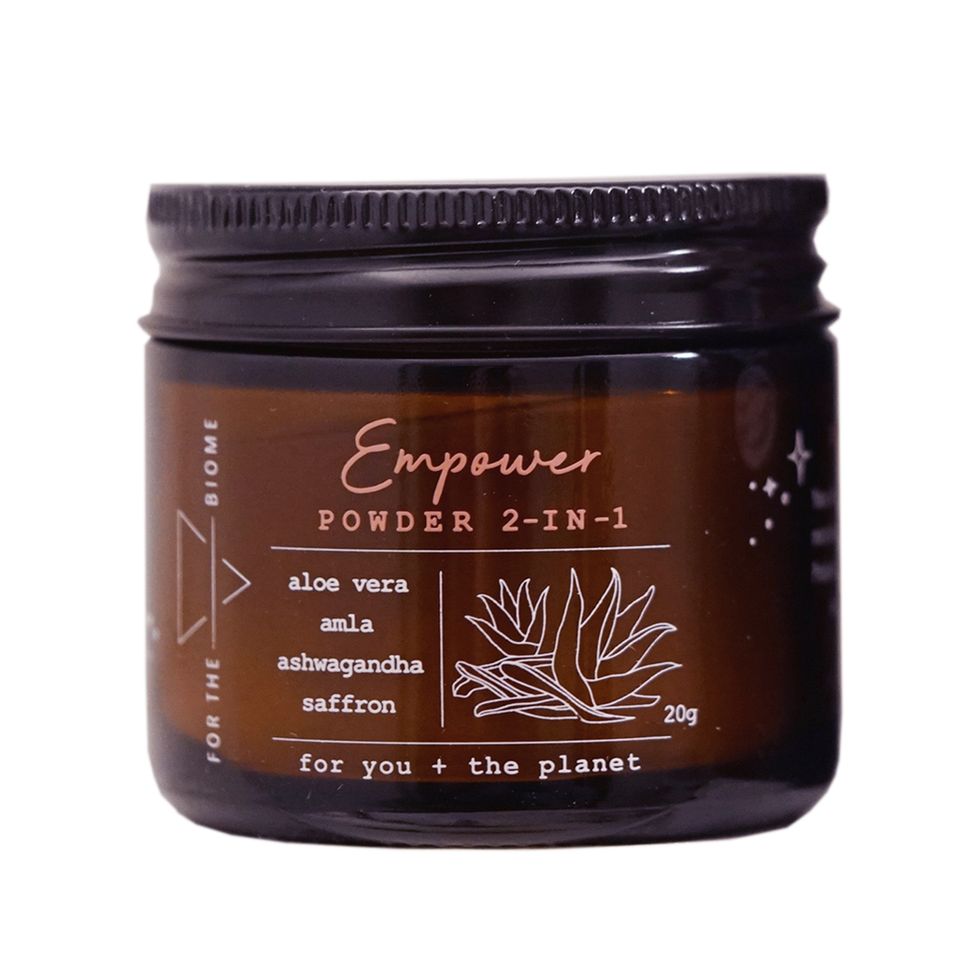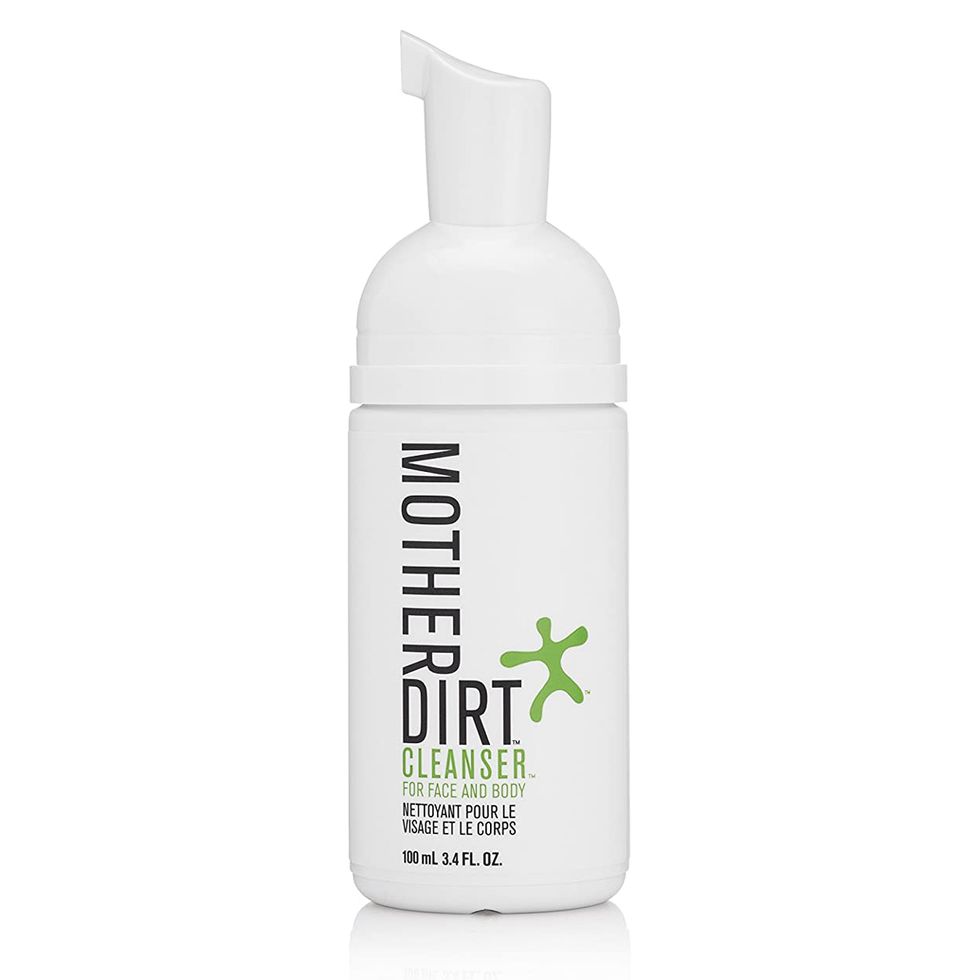Health
Your Skin’s Microbiome Wants to Be Left Alone—Thanks
A message from the one trillion microorganisms living on and in your skin.

21 October, 2020
10 November, 2021
There are 100 billion stars in our galaxy. That fact might make you feel small when you peer up at the night sky. Inconsequential. In awe of the vastness of the universe, and suddenly aware of all that is unknown—and perhaps unknowable—to the human mind. Staring into the great expanse of the cosmos, could you fathom even attempting to control it? Trying to make the stars glow brighter, or the planets orbit faster, or the moon move closer? No. For all that we don’t know, we do know this: To alter the delicate balance of the universe would be to destroy it.
Take all that awe and awareness, and all that appreciation for the inner workings of outer space, and multiply it by 10. Welcome to the wonder of your microbiome.
Take all that awe and awareness, and all that appreciation for the inner workings of outer space, and multiply it by 10. Welcome to the wonder of your microbiome.
What Is the Microbiome?
“Our microbiome is the natural collection of microorganisms that live symbiotically with our bodies,” Dr. Joshua Zeichner, a board-certified dermatologist with Zeichner Dermatology, tells Coveteur. The human body is home to various microbiomes—the gut microbiome, the oral microbiome, and for some, the vaginal microbiome—but for now, let’s focus on the buzziest microbiome in beauty: the one on your skin.
The skin microbiome alone is home to an estimated one trillion (!!) microorganisms, made up of thousands of strains of bacteria, fungi, mites, yeasts, viruses, and protozoa (the single-celled eukaryotes, not the intergalactic superstar from the Disney Channel Original Movie Zenon: Girl of the 21st Century). While such an amalgamation of life forms might not sound great, let me assure you, it is.
Science is just starting to understand everything the skin microbiome does, but for starters: It’s an essential part of the body’s immune system. It’s intrinsically connected to the gut and the brain. It’s responsible for the functioning of the skin barrier. It keeps you moisturized, exfoliated, protected, and pH-balanced. A thriving microbiome is known to prevent “eczema, rosacea, acne, and even premature aging,” Dr. Zeichner says. It is, in short, the single most important element of skin health.
Where Does It All Come From & Where Does It All Go?
The microbiome is with you from birth, when an individual’s skin gathers its first bacteria from the mother’s vaginal canal. According to the research in Clean: The New Science of Skin by Dr. James Hamblin, a trained physician and medical reporter with The Atlantic, some of this bacteria stays with you for life. The microbiome only grows from there: It continues to pick up microorganisms from breast milk, human interaction, diet, and the environment (animals, air, soil, you name it).
These microorganisms are scattered throughout the skin barrier, otherwise known as the stratum corneum, the uppermost layer of the epidermis. Some sit on the surface, some burrow in the pores—it’s all intertwined. “My vision of the skin barrier is this whole skin ecosystem of both the stratum corneum and microbiome,” says Dr. Elsa Jungman, who has a Ph.D. in Skin Pharmacology and is the founder of her eponymous (microbiome-friendly) skin-care line.
An ecosystem is the perfect way to think about it, actually. Your skin is the environment and your microbiome is the community of living beings inhabiting the environment. And as we can see from what’s happening to our environment—you know, the earth—it prefers to not be polluted with unnecessary stuff, thanks.
Microorganisms are the Original Skin-Care Products
Everything you currently rely on a skin-care product to do for you, the microbiome and its host (your skin) do all on their own. Like, everything.
Some of its one trillion microorganisms signal the skin to produce lipids, like ceramides, to keep the barrier strong and seal in internal hydration. Some feed off sebum, the skin’s natural moisturizer, to keep your oil levels in check. (In Clean, Dr. Hamblin proposes that oily skin may not be a product of oil overproduction at all, but of microbial imbalance: The skin is missing the microorganisms that “eat” the oil, making the skin appear overly oily.) Others feed off dead skin cells, essentially taking care of all your exfoliation needs, and still others produce potent antifungal and antimicrobial compounds.
“Good bacteria on the skin are part of a checks-and-balances system that prevents overgrowth of bad bacteria,” Dr. Zeichner adds—although “good” and “bad” are oversimplified terms for what’s happening here. For example, C. acnes, the “bad” bacteria associated with acne, is an essential component of a healthy microbiome. It only becomes “bad” when there aren’t enough “good” bacteria to keep it from taking over. These “good” strains of bacteria also “help inhibit inflammation, maintain hydration (think anti-aging), and maintain optimal pH, which also helps prevent pathogenic growth,” Dr. Nadia Mussavir, a naturopathic doctor who specializes in skin health, tells Coveteur.
In fact, it’s likely that what we think of as the acid mantle—the slightly acidic layer of the stratum corneum that keeps invading bacteria, viruses, and contaminants from penetrating the skin—is not a separate part of the skin barrier, but a byproduct of the microbiome. “Acidity is the normal state of the ecosystem of the skin, harboring the microbes that help us live,” Dr. Hamblin writes. Basically, the acid mantle is made possible by “a rich diversity of non-dangerous microbes.”
The skin microbiome’s abilities aren’t limited to skin care. (Remember, it has one trillion moving parts.) Dr. Musavvir notes the existence of the gut-brain-skin axis, which proves that the bacteria in the gut influence the bacteria in the skin and vice versa.
As for the “brain” part of that axis? Early research shows that some strains of bacteria on the skin may impact mental health. “Certain lactobacillus that are growing on your skin create compounds like oxytocin,” says Paul Schulick, a master herbalist, microbiome expert, and founder of For The Biome. “One of the most exciting strains is called DR7, which is capable of enhancing the serotonin pathway.” That’s why every For The Biome box bears the words “Your keratinocytes [skin cells] are smiling.”
Sorry, but Your Microbiome Is Probably Compromised
“Everything we do—and don’t do—to our skin has some effect on these populations,” Dr. Hamblin declares. And these days, we’re doing entirely too much and too little.
Let’s start with the “too little” part. Modern Western living typically involves less exposure to the outdoors, less exposure to other people, and therefore less physical touch, fewer vaginal births, and fewer fresh fruits and vegetables; all vital sources of microorganisms. (More on that in a minute.)
What’s worse, though, is that we’re actively harming the microorganisms we do have with too much pollution, too many harsh medications, and too many topical products.
“Regarding skin conditions, [dermatologists] have been treating the abundance of C. acnes in acne with antibiotics,” Dr. Jungman says. “We are learning that those therapies are not working long-term, as they are attacking the whole microbiome and not the specific bacteria that is causing the issue, leading to long-term damages and resistance.” (This goes for both oral and topical antibiotics, including those prescribed for conditions not related to the skin.) In Clean, Dr. Hamblin posits that antibiotic overuse is one of the biggest contributors to “messing up our microbiomes.”
Other standard prescription treatments may harm the microbiome as well, including isotretinoin, also known as Accutane. This drug works by shrinking the sebaceous glands, leading to less sebum production and therefore, for some patients, less acne. But since sebum is a vital food source for the skin’s beneficial bacteria, the medication has the unintended effect of exacerbating microbial imbalance and potentially creating long-term skin issues: barrier damage, chronic dryness, and in many cases, recurring acne. (It’s worth noting that these go-to dermatological medications were created and researched in a time when the role of the microbiome wasn’t fully understood or even acknowledged.)
The other, more ironic reason your skin microbiome isn’t functioning properly? Um, that would be your skin-care routine.
Every single time you slather something on your skin—no exceptions! even water!—you “at least temporarily alter the microscopic populations … either by removing them or by altering the resources available to them,” Dr. Hamblin writes. The introduction of outside chemicals “can damage your skin microbiome and stratum corneum,” Dr. Jungman adds, “and the protective function of this ecosystem can be lost.”
Layering on all sorts of essences, serums, moisturizers, and oils also affects the microbiome’s ability to thrive. “If these bacteria are living in an ocean made of silicones and mineral oil, it’s not their natural environment,” says Sue Nabi, former president of L’Oreal and Lancôme and founder of vegan skin-care line Orveda. “It’s like taking a fish from the sea and putting them into [fresh water]. It would kill them. It’s the same for the bacteria you have on your skin.”
Of course, there are certain skin-care ingredients that are more harmful to the microbiome than others. “For cosmetics, preservatives are essential to protect a product from contamination, but today we know that those antibacterial ingredients can affect our skin ecosystem once they are on the skin,” Dr. Jungman says, since preservatives exist precisely to impede bacterial growth.
Dr. Hamblin’s research corroborates this claim: “Anything with a preservative in it is probably damaging some part of your microbiome,” he writes, and practically all skin-care products (barring waterless formulas and oils) contain preservatives. Parabens are particularly problematic. “The National Institute of Allergy and Infection Disease have found that products containing parabens can block the growth of Roseomonas mucosa from healthy skin,” as he reports in Clean. “This bacteria seems to help improve the skin’s barrier function and can directly kill the Staph. aureus that proliferates during eczema flares. The researchers raised the concern that through this chain of events, parabens could leave people more susceptible to eczema flares.”
“So many ingredients are antibacterial, not just preservatives,” Dr. Jungman says. “For example, essential oils or fragrances.” She’s also concerned about the effects of emulsifiers and soaps or simply using too many ingredients in general. “The more products we use with a lot of ingredients, the more it can damage our skin barrier and microbiome,” she laments. “Experts recommend choosing cosmetics with simple formulations, possibly with less than 10 ingredients.”
Why Does It Matter That Your Microbiome Is Compromised?
Research increasingly shows that an imbalanced microbiome is often to blame in cases of acne, eczema, dermatitis, psoriasis, rosacea, premature aging, dry skin, oily skin, sun damage, hyperpigmentation—oh, every possible skin issue, really. When these issues pop up, our instinct is to turn to products that replace the inherent functions of the microbiome (even if we don’t realize this is what we’re doing).
This can sometimes help in the short-term, but it doesn’t allow the microbiome to thrive in the long-term. Again, it may be helpful to compare it to the earth’s ecosystem: After a while of being immersed in an environment that's not supportive to life (think carbon dioxide, methane, all sorts of manmade pollution), it rebels (think climate change). Temporarily squashing the rebellion (putting out a forest fire, shrinking a pimple with benzoyl peroxide) does not fix the underlying issue (a polluted environment, a compromised microbiome).
How to Support Your Microbiome
Luckily, building up your microbiome is very easy. Step one? Stop using so much skin care. “I would recommend really limiting your skin-care routine to gentle cleansing and moisturizing, only as necessary,” Dr. Jungman says. “Always look at all the ingredients in a product to make sure they are not too many and they are not too harsh.”
Some other, science-backed, non-product-driven ways to increase your microbial diversity include getting a pet, getting enough sun, exercising, living with roommates (seriously), touching other humans (safely and with consent, of course, especially in the time of coronavirus), eating fresh fruits and veggies (an apple contains 100 million microbes), spending more time outdoors, and drinking less alcohol.
What About Probiotic Skin Care?
As the microbiome has become more widely recognized in the beauty industry, probiotic skin care has become more popular—but it may not be as beneficial as beauty brands would have you believe. Probiotic products typically only contain one or two strains of bacteria, and considering healthy skin contains hundreds of different strains, “I think it’s a little bit of hubris to think that you’ve got the one strain that’s going to change the entire thing,” Schulick says.
“A lot of probiotics claims in cosmetics are pure marketing,” Dr. Jungman adds. “What is important to understand is that probiotics are live [bacteria], but in the very large majority of the products marketed today as skin probiotics, they are actually dead, which is very different.” (This is due to the preservatives they’re packaged with, which, again, are bacteria killers.)
A better option might be to use preservative-free probiotic products, like those from Mother Dirt, or simply DIY a yogurt face mask at home. (The probiotics in yogurt are the same strains found in skin-care products, except they’re alive and well.) “While more research is needed in this area, there is evidence that topical applications of [live] probiotics are beneficial for different skin concerns including acne and even aging skin,” Dr. Musavvir says. “Taking an oral probiotic can also support a healthy microbial balance” from within.
Prebiotic Skin Care Seems Promising
“Most ‘probiotic’ skin care actually contains prebiotics, which is essentially food that supports growth of healthy microorganisms,” Dr. Zeichner says. “Examples include colloidal oatmeal and mineral water rich in selenium,” as well as honey. This is perhaps a more holistic approach to building up your microbiome topically, since prebiotics will theoretically feed more strains of your own bacteria.
Of course, it’s also important to eat them. “There’s evidence that if you feed yourself a diet rich with prebiotics”—like fiber—“you will produce more butyric acid, which will therefore find its way to assisting the skin’s microbiome and the skin’s health in general,” according to Schulick.
The Future Is Postbiotic
“The whole value of a prebiotic is you’re going to create a really good array of postbiotics,” Schulick says. In other words, prebiotics feed the probiotics (the bacteria in your microbiome), which are then able to produce postbiotics: the lipids (like ceramides) and proteins (like peptides) that a healthy microbiome produces on its own but a compromised microbiome does not (and which are essential to healthy, even skin). “In my opinion to the stage where the research is today, postbiotics are the most interesting compounds,” Dr. Jungman agrees.
At For The Biome, Schulick creates postbiotics by fermenting natural prebiotics like oats and Manuka honey. “You don’t have to spray a probiotic on your skin and hope it’s going to grow there, and grow what it should grow,” he explains. “We do that work for you.” The postbiotics are delivered via products that are water-free and thus preservative-free—and that’s as microbiome-friendly as topical skin care gets.
Still, as Dr. Hamblin declares in Clean, “We can try to control or coat [the microbiome] with topical products, but it is ultimately a force of nature.” The awe-inspiring power of the one trillion bacteria, fungi, mites, yeasts, viruses, and protozoa living on your skin can’t be bottled.
Shop 7 Microbiome-Friendly Products for Your Skin and Body:
Want more stories like this?
So You Have Melasma—Now What?
Breast Cancer Prevention Through the Ages
8 Your-Skin-But-Better Foundations That Won’t Clog Your Pores
So You Have Melasma—Now What?
Breast Cancer Prevention Through the Ages
8 Your-Skin-But-Better Foundations That Won’t Clog Your Pores











